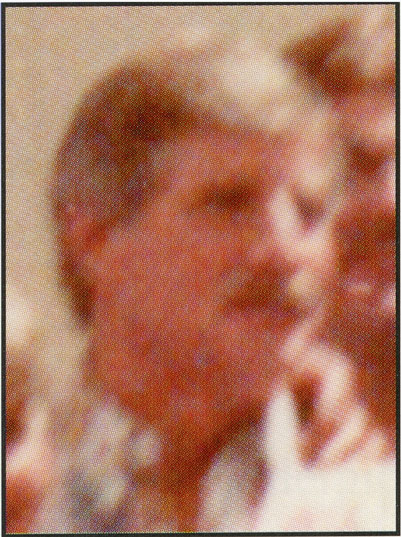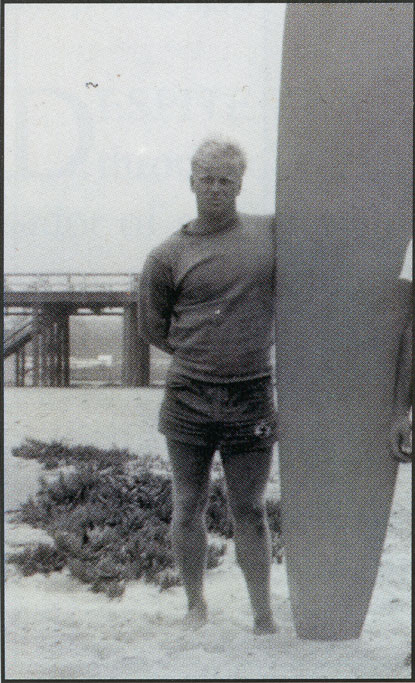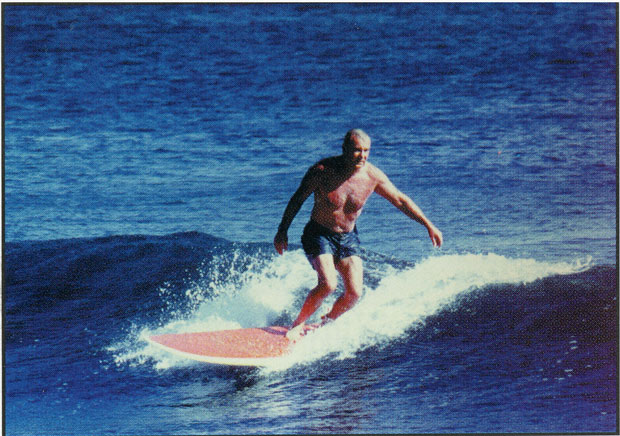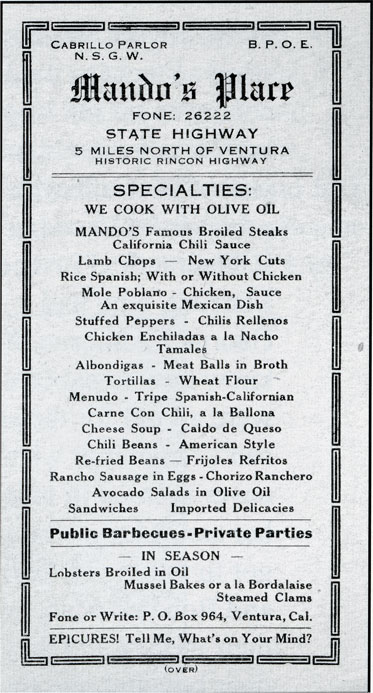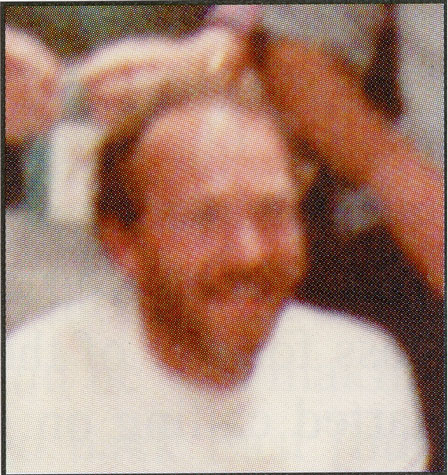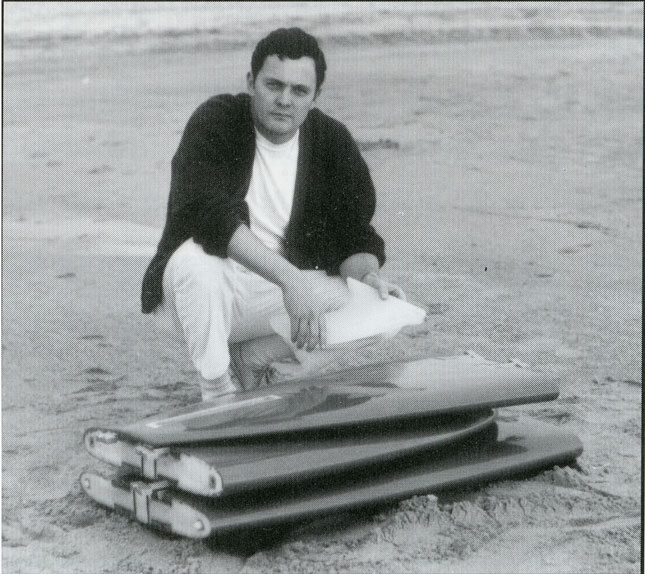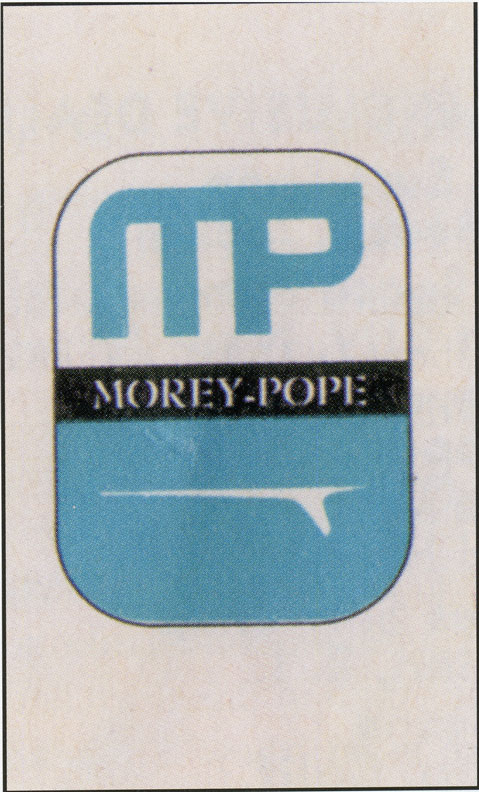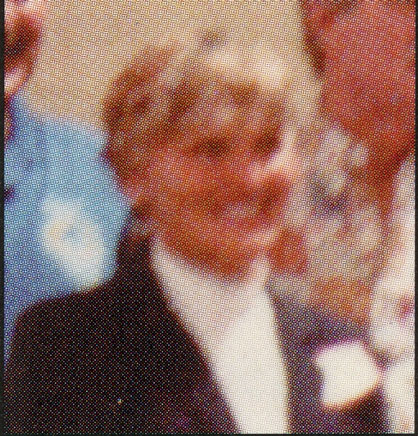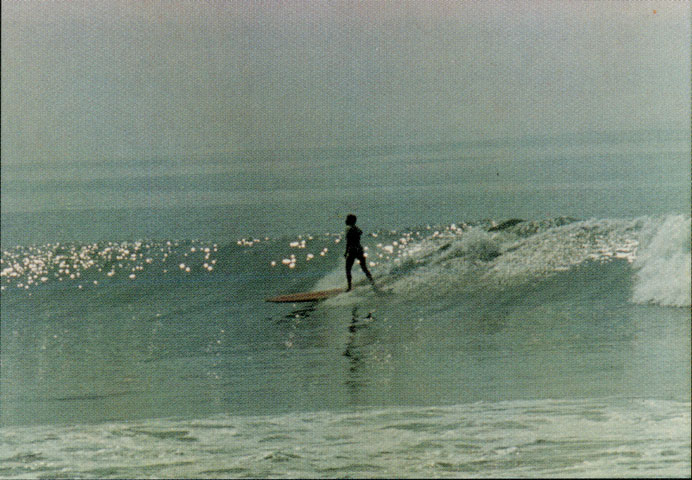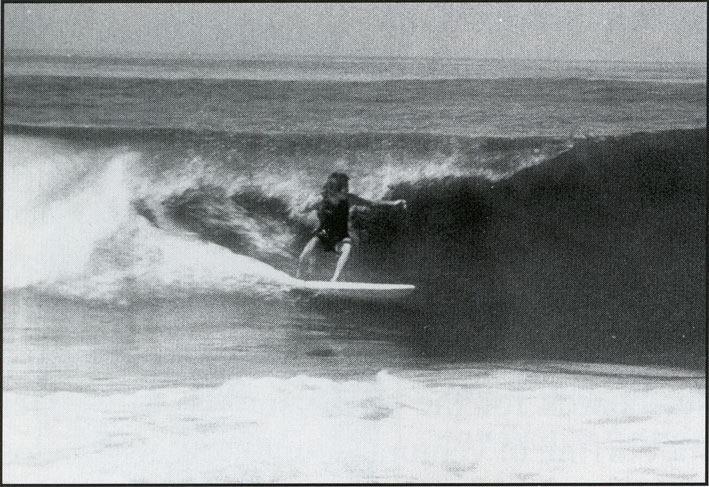In this month’s Journal Flashback we continue with “In the Curl: The Evolution of Surfing in Ventura County” from MVC Quarterly Volume 44, No. 3 (2000). Last month we learned about the introduction of surfing to Southern California. Part II features local surfers who were interviewed and shared their fondest memories of learning to surf and how surfing has changed over the years. The journal ends with Stan Fuji’s 2000 take on the future of surfing. It’s interesting to think what has changed not just since surfing’s “heyday” but since this journal was published in 2000. Enjoy!
About the Questions & Answers
Responses to questions listed with each surfer are excerpts taken from recorded interviews and completed questionnaires. They are presented, largely, in the form in which they were received. Only obvious errors in spelling have been corrected, and no attempt has been made to make these entries more uniform. Editor’s additions within the text are placed in [brackets]; information obtained outside of the interview proper is italicized.
The Contributors and Interviewees arranged in the order they started surfing.
Bill Flores
Bill Flores was born in Ventura on June 25, 1914, in the “next to the last house on South Palm Street – a few hundred yards from the beach.” He attended May Henning, Lincoln and Ventura High School and completed one year at Ventura Junior College. For many years Mr. Flores worked at the Kellogg Seed Company, near the intersection of Front and Kalorama Streets. He retired in 1979, at the age of 64. Mr. Flores is 86 years young.
Can you describe the first time you went surfing, where this occurred, who was there at the time, and any feelings you have about that day?
I first surfed in the early 1930s. I was the only one on a surfboard. Made up my mind I would learn to stand on it. [Later, in conversation, Mr. Flores said he felt it must have been about 1932.]
At the time you started surfing, can you recall who the “older guys” were at local surf spots? Do you recall any early female surfers?
The older guys were from the L.A. area. No females. [Mr. Flores later recalled a lifeguard named “Peterson” as one of the first surfers he saw in the water. This is very likely the legendary Santa Monica lifeguard Pete Peterson, who surfed many Southern California spots in the 1920s and 1930s.]
How (or from whom) did you acquire your first surfboard? Do you recall what you paid for this board? At that time what options were available to someone who wanted to acquire a surfboard, local or otherwise?
My brother [Emilio Flores], who was a lifeguard, gave me a paddleboard he had made by Austin Pearly, head of the Park Department. I know of no one who made surfboards in this area. [Mr. Flores later indicated this was the only board he ever used; it had oak sides, a drain plug on top that leaked, and no fin.]
From your time in the water, are there one or two memories that stand out from all others – people, waves, trips, equipment, etc.?
Two memories. When I first learned to stand on my board, and later when I caught a good size wave between Palm and Figueroa Streets and rode it almost to California Street.
Have you had any experience with dolphins or sea lions? While surfing?
No experience with dolphins or sea lions.
When was the last time you went surfing? If you no longer surf, what reasons contributed to this decision?
Can’t remember last time I surfed. I had to quit because I hurt my knee falling off my board and I had a steady job in the day and [was] playing music at night. [Later with the help of his wife, Carmelita, he estimated that he quit surfing about 1956, when other surfers started to surf “Palm Street.” His love of instruments and music, especially Hawaiian music, eventually landed Mr. Flores a 6-month job in Hawaii in 1977, playing Hawaiian steel guitar. Some of the musicians he met there later came to the mainland for a visit. Mr. Flores still plays a number of instruments.]
Do you have any feelings about surfers and/or surfing today?
I envy all the surfers and wish I could join them.
Is there anything else you would like to add?
Nothing.
Jack Herron
Jack Herron was born in Long Beach, California, on February 24, 1927. He attended Lowell Elementary, Rogers Junior High, and Wilson High School, all in Long Beach, as well as Long Beach City College. He arrived in Ventura County in 1952, where he attended Ventura City College, then the University of California, Santa Barbara, falling a few credits short of a degree, to his “eternal regret.” While an employee at Shell Chemical on Ventura Avenue, Mr. Herron established Pacific Plastics, located on Ramona Street, near Olive Street, in the late 1950s, which supplied surfboards to a number of large retail outlets including White Front, Sears, Zodys, Abercrombie & Fitch, and Montgomery Ward; brand names included “Kon Tiki” and “Duke Kahanamoku.” He sold this business to Bill Fisher between 1961-1962. It was Herron’s feet that served as the original model for the now famous “Hang Ten” brand. How this locally designed logo became a nationally recognized commodity is a story in itself. Mr. Herron and his wife, Shirley, now divide their time between a home in Long Beach and a 42-foot boat in Alamitos Bay.
Can you describe the first time you went surfing, where this occurred, who was there at the time, and any feelings you have about that day?
The first time I went surfing was at Belmont Pier, Long Beach, in 1939 … I was 12. The board I was using was a hollow paddleboard, 12 (!) feet long. I recall that Dick Dupuy and Walt Ingraham were present. I was hooked. This was pre-breakwater Long Beach surf and it was BIG, the board was WAAAAAY too big for me, but I embarked from that day forward on a mission to surf every wave I could. Days later, Dick Dupuy and I bought a solid redwood board, 10 feet long that must have weighed 100 pounds. It took both us skinny water rats to carry it to the beach.
At the time you started surfing, can you recall who the “older guys” were at local surf spots? Do you recall any early female surfers?
Hard to believe now that I was once one of the younger ones, but I do recall Bob “Hammerhead” Gravich, if I’m recalling the spelling correctly. He was attending USC, lived in an old milk truck, and must have been about 20 when I was 12. The earliest female surfer I can recall is Mondo Mary, in about 1955.
How (or from whom) did you acquire your first surfboard? Do you recall what you paid for this board? At that time what options were available to someone who wanted to acquire a surfboard, local or otherwise?
Bought my first surfboard from a friend of Hammerhead. We paid in the neighborhood of $10…BIG money in those days, earned from paper routes, and dishwashing in restaurants. No surf shops in those days. The board was homebuilt, shellacked to keep the water out, but that didn’t work too well. Those 100 pounds quickly seemed to become 150.
From your time in the water, are there one or two memories that stand out from all others – people, waves, trips, equipment, etc.?
Which memories to choose … probably August ‘57, Trestles, perfect glass-off with 10-12’ beautifully shaped waves, and only 10 of us in the water. Each of us with a wave to ourselves. It seemed to go on forever and I’ll never forget it. I can see it, feel it, it’s vivid today as I write about it. Another day, November of ‘59, at Rincon, surfing with Bartels, [Reynolds] Yater, Ole Olsen, Jack Haley, Dale Velzy, Tom Leggett, Dave Ashrow, Jack Cantrell, and Harold Hildebrand, stands out. Perfect 10-12’ tubes. It would be interesting to see if any of them recall that day. I’ll bet they do.
Have you had any experience with dolphins or sea lions? While surfing?
The only non-human encounter I can recall is a school of killer whales coming through Rincon, probably winter of ‘58 or ‘59. Probably 15 of us in the water watched about 4 swim past us. Awesome. I was too ignorant to be scared.
When was the last time you went surfing? If you no longer surf, what reasons contributed to this decision?
Last time I went surfing … about October of ‘61. I’ve told you the story… [In an earlier telephone conversation Mr. Herron had spoken about this day, which was at Rincon Point. Surrounded by friends, perfect waves, more than anyone could catch. Surfed out, beautiful day, a great way to leave the water. He was then 34 years old.]
Do you have any feelings about surfers and/or surfing today?
Surfing today…small boards, the leash, and wetsuits have changed the sport dramatically…yes, for the better since today the athletes can do things we didn’t even dream of. Incidentally, I still have a hard time putting on a wetsuit. My wife reminds me that 15 year-olds today wear them all summer long. If I have to go into 59-degree water in winter to unfoul the prop on my boat, I still go in bare. Stupid, but there you have it.
Is there anything else you would like to add?
Something more I’d like to add: Any information you receive to the contrary notwithstanding, I started the first surf shop in Ventura County.
Jack Cantrell
Ned Bartels was born in Goodland, Kansas, on September 8, 1935. In his own words, “My parents moved to Ventura in 1936 or 1937. I grew up on the Avenue. The Avenue in 1938-1956 was a grand place to grow up. I grew up during World War II. I was drafted into the army in 1958 to 1960, when everyone went into some service. The school system then was a 6-4-4 plan. Six years of grammar school, 4 years of junior high and 4 years of senior high and junior college. I went to junior high in 1947; the seventh grade. The name of the school was Ventura Junior High School Mariners. Just down from the school was the ocean. We could see the pier from our classrooms (what a bad place to build a school). It was a magnet for the kids who loved the water. I only remember about 5 or 6 kids that liked the water as much as me.” A retired Hueneme and Channel Islands High School teacher, Bartels now operates his own furniture repair business, specializing in custom wood turning. He lives in Somis, California.
Can you describe the first time you went surfing, where this occurred, who was there at the time, and any feelings you have about that day?
In the summer all the kids (boys and girls) went to Seaward Beach. Betty’s Tavern was washed away in the 1939 storm, and the remains were a great place to be warm after bodysurfing. Surfboards were not even in our vocabulary. We did know of a guy that rode a paddleboard down by the pier on Sunday afternoon sometimes… A football coach from the J.C. was the lifeguard for the city at Seaward [Avenue]. His name was Museil. He was a water boy from down south somewhere. He was a great bodysurfer and we really got with the program with him to teach us. Some names I remember of the good bodysurfers were Darrel Hollowly, Richard and John Fletcher, Eddie Triberg, Richard Lane, Loren Garcia, Darrel Callaway and myself. [In a subsequent conversation, Bartels estimated that he started surfing around 1948-1949.]
At the time you started surfing, can you recall who the “older guys” were at local surf spots? Do you recall any early female surfers?
A fireman in town was a guy named Mike Melrose. He came from Venice Beach. He was a redwood board surfer. You had to be Charles Atlas to carry one of those 12-ft. monsters that weighed 120 lbs. down to the beach. It was like surfing the Forrestal aircraft carrier. You paddled on your knees. When you got that thing started you couldn’t stop it. Mike was always giving us kids the what-for about redwood boards and how we could have one that he would build for us at the firehouse with the best spar varnish money could buy. Mike would bring his board to California Street, hoist it on his shoulder, walk over the rocks and paddle out. He would point that baby to the exact point on the beach where he wanted to end up and take off on the best wave of the day. If he wanted to turn a little he would drag a foot for about 5 minutes to turn 3 degrees. He could do a hoe-down on that board… In 1951 some Hawaiians came to Ventura to go to Ventura J.C.: Art Mochizuki, Jim Kim and Danny Wolkie. Art surfed and played the uke. Art taught us the fine art of surfing Hawaiian style. We went to Mondos because it was a good place to learn. WE HAD FUN. Other guys found us or we found them. Jack Herron, Ken Kesson, Charlie Price, Richard Holst, Jim Williams, Greg Underwood, Ken Hilderbrand, Jack Strathy. Old firehouse Mike found Jack Cantrell. Jack had an oil business selling to stations and would come out when he could. Jack wore tennis shoes to surf in. We called him “The Tennis Shoe Kid.”
How (or from whom) did you acquire your first surfboard? Do you recall what you paid for this board? At that time what options were available to someone who wanted to acquire a surfboard, local or otherwise?
A friend of mine named George Lanthorne and I went together and drove to Grant Lumber Co. in Hawthorne and bought some balsawood, came home by way of Velzy and Jacobs’ surf shop in Venice and learned how to build surfboards. We glued up 5 pieces of 4-inch thick balsa and started shaping. Round nose, flat bottom and square wide tail. Ten feet long by 22 inches wide. We did all the work at Mondos. George was older and had a car. We left our board in the storm drain culvert under the road. About this time Walter (AKA “Pete”) Marriott went to Mike Melrose and had a redwood board made … I became aggressive in the water and made lots of different boards for myself. The one that lives in infamy was “THE RED BANANA.” It was what we called a hot curl board. Short (9ft.) and slim (18 inches). This board had a nose like a spear and it was red. I was the only one who could ride it or even wanted too. When you took off on a 6 ft. wave at Rincon you could make every wave. You couldn’t turn or slow down or anything else but man you flew. I took a lot of guff over that board.
From your time in the water, are there one or two memories that stand out from all others – people, waves, trips, equipment, etc.?
We always took trips to the south beaches in the summer. We had no surf around here in the summer. We would go to San Clemente and sleep in the hole by the railroad tracks and the anthills. We surfed San Onofre, Trestles, Cottens Point, Wind in Sea and any others that looked good. Coming back from one trip I had 5 boards on my surf rack on my 1950 Plymouth 4 door sedan. We were cruisin’ along on PCH and boards, rack and the whole 9 yards came off like a frisbee. Just missed an 18 wheeler and 39 other cars. Broke Charlie Price’s skag and that’s all … WOW!
Have you had any experience with dolphins or sea lions? While surfing?
Overhead (Emma Wood State Beach) came up about once every three years. It had to be 10 ft. before it would break. One summer day we had a very large west swell and Overhead was up. It was about 15 ft. and glassy. We had about 5 guys out. Great waves, take off on one side of the peak and cross over under a large break. We were having a great time, when we saw some killer whales coming down the coast. I had read stories about killer whales attacking boats and other things. I got out of the water. The other guys didn’t. I was watching them surf when a killer whale passed between the surfers and me. That’s the same day I took my trunks off to get some sun on my rear end and got so sunburned I couldn’t sit down for a week.
When was the last time you went surfing? If you no longer surf, what reasons contributed to this decision?
In August the U.S. Army wanted my body, bag and baggage. I was drafted. I went to Ft. Riley, Kansas then to Baumholder, Germany for two years. One night we went to the movies at the base and a movie was on called Gidget. It was about some chick that wanted to surf with the big kahuna at Malibu. Well, I almost went A.W.O.L on that. I sold all my boards when I went in the army knowing things would change and a better board would be out when I came home. Jack Herron started a surfboard shop and I was sending him money for a new board when I came home. I got out of the army in August of 1960. I went to Jack’s surfboard shop and got my brand new board. I headed for the beach for a try out. What the hey!! 37 guys in the water and 429 on the beach that were “want to be’s.” I tried to go [out] a few times but I was married with a child and I knew it was time to move on with life.
Do you have any feelings about surfers and/or surfing today?
I have gone out a few times with my kids. They turned out to be water people too. I do some bodysurfing from time to time. But no boards. Too many people and too few waves.
Is there anything else you would like to add?
I had the best of the best of surfing. Good guys, great gals, excellent waves and summer days to enjoy from 1949 to 1958. I was 14 to 23 years old. Nice to look back on.
Jack Cantrell
Jack Cantrell was born in Oxnard on Halloween in 1928. He attended Sheridan Way Grammar School, Cabrillo Jr. High, and Ventura High School. He graduated from high school in 1946. He went into the army and served in Japan during the Occupation, where his duties in the military police included serving as an escort for visiting generals and congressmen, and even Emperor Hirohito. He came out of the army in 1948 and returned to Ventura College, where he graduated in 1950. In 1953 he started the Jack Cantrell Oil Company, delivering oil to Ventura and Santa Barbara counties. In 1964 he started Windward Sailboats at the new Ventura Marina, where he worked on the weekends. He also sold boats for Jensen Marine and Schock Boats. When the Ventura Marina was damaged in the flood of 1969, he went out of the boat business. At that time, he bought a house at Faria Beach to be near the water and continued to work in the oil business until his retirement in 1989. In 1991 he became heavily involved in the establishment and opening of the “C Street Surfing Museum,” located at the foot of California Street. In January 1992, he had a heart attack while surfing. Although his heart was damaged, he did not require surgery and was back in the water within four months. In 1996 he went to work for BTC Engineering, from which he retired in August 2000. He continues to surf and swim with his daughter, Christy, in front of his house at Faria Beach and can see the surf spot, Mondos, from his beachfront deck. In late September 2000, he will be going to Tulsa, Oklahoma, to attend the wedding of his youngest daughter, Caryl. He has a serious t-shirt collection.
Can you describe the first time you went surfing, where this occurred, who was there at the time, and any feelings you have about that day?
After I finished Jr. College in 1950, I worked for the City of Ventura for a couple of years, and I met this fireman named Mike Melrose. I happened to run into him one day at Mondos. He had a redwood surfboard that weighed 84 lbs., and he was surfing. The surf wasn’t very big. Anyway, I asked if I could try it out and he said “sure,” so I paddled out and I caught a wave, and I guess it’s standard procedure to say you were “hooked.” And that’s how I began surfing. I began surfing the end of summer, about August of ‘53.
At the time you started surfing, can you recall who the “older guys” were at local surf spots? Do you recall any early female surfers?
Well, what I’d like to do is mention Bill Flores. I used to go down to California Street. My mother used to take me down there and dump me off. She used to dump me off at two places: San Jon Road, where the lifeguard station is now, and she used to dump me off at California Street. Where the bath house was—where Bananas and the parking structure are now. I was down there probably [at age] 12-14 years old. There was a guy out on—I think it was a paddle board—I think it was black and white mixed in with a color. I remember seeing him on a paddleboard, but I didn’t really know what he was doing at the time. This was during the war years very possibly – World War II.
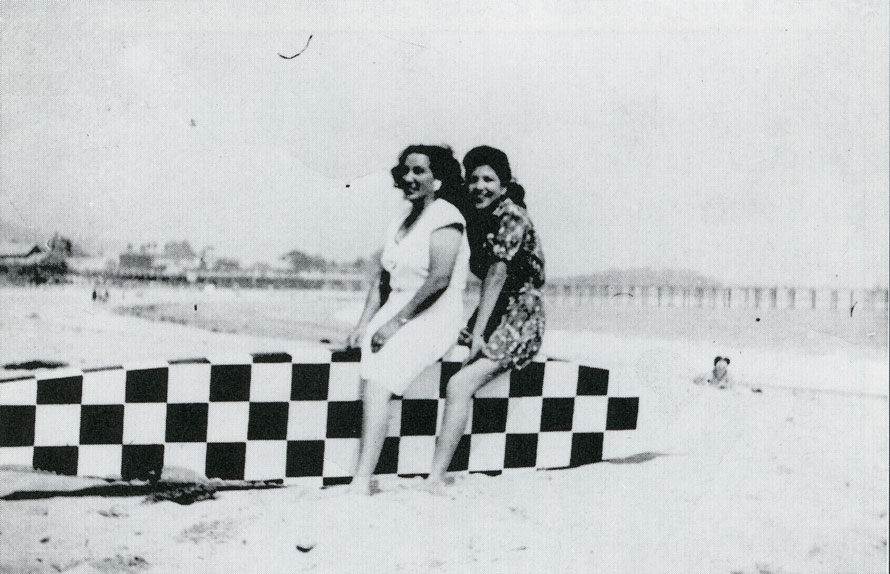
Anyway, that was the first time I ever saw anybody in the water on a paddleboard or surfing. I don’t remember any other boards [at the time], but there were people in Ventura that I learned, later on, who had boards, and I know some of them—I mean they were local guys—but you could count them on your fingers… there was hardly anybody surfing at that time. That winter I went to the Rincon … I got kind of an education out there. The Rincon, even on the weekend, had 10 guys probably. [At Rincon] I can remember very few guys from Santa Barbara, there was Jeff White, and a guy named McCaffrey, who’s been dead a long time. And then we had a small group from Ventura. There was Ned Bartels and Charley Price, Carroll Hildebrande. I just can’t remember the very, very first ones. There was Pete Marriott, who had a board at the time. I think Ron Hertel had a surfboard, George Lanthorne. It was a very small group, and everybody was—I don’t know how to explain it to you—but everybody was very friendly, and we were all out for the same thing—to have fun. I was at Rincon one winter—I can’t remember what year. I’m going to say the middle ‘50s sometimes (I never seemed to talk to a lot of people), but Mary and her husband, Bob, and her son, Larry, who was about 13 or 14, they were watching us surf there. I got to talking to them, and anyway, Mary said she was going to get a board, and Bob and Mary were not wealthy people, and they both worked and saved their money and they bought boards. I think they bought three boards, one for their boy and one for themselves, and they started surfing the Rincon. Mary was very friendly, she talked to everybody … I liked Mary, and my ex-wife, Joyce, liked Mary, and I used to call Mary up and say, “Do you want to go to Secos, or do you want to go to the Rincon?” and she’d always say, “Yes.” She lived here at Faria Beach, but we didn’t surf here then, so we didn’t even know it was surfable. We knew Mondos could be surfable, but, actually, there was a surf break right in front of her house. When the Rincon started getting crowded—I can’t tell you what year it was—I’m going to say late ‘50s or early ‘60s—Mary said, “I wonder if we could surf here? So we started surfing in front of her house. We were probably the first people that surfed what they call “Mary’s” or “Grannies” or “Pitas Point.” Anyway, we were surfing Mondos and I thought, gee, I don’t like that name Mary Monks, so I just kind of named her Mary Mondos, and everybody just picked up on it and she never complained. Oh, there was a woman named Joanne Hill, who had been surfing before Mary, and she lived at Faria Beach also, and she had an old Simmons board that she sold to Craig Underwood. And Joanne Hill, if she were alive today, she could probably give you some information. Joanne probably surfed before I did, in fact, I’m positive she did… she lived here at the beach, but she passed away a few years ago of cancer. A very nice lady.
[About the namesake of the surf spot, “Mondos”] Mondos Steak House was torn down in 1954, and Mrs. Baptiste, who owned the property here, she gave a man named LaSalle the lot, he tore down Mondos Steak House. … I stopped by to see that lot, and I asked Mr. LaSalle if he wanted to sell it. I thought I could build a little redwood beach cabin out there. He said, “I don’t want to sell it.” [Later on] he called me up and he said, “Jack, I’ve changed my mind. I’d like to sell that lot.” What do you want for it? He said, “I want $1500 for the lease, and I’ll build a new sea wall.” He built sea walls out of used telephone poles … It was a huge lot, about 100 feet wide … big enough for three houses. And he wanted $1500 for it, and I told him I was sorry I didn’t have the money to buy it; I had just put a $1000 down on an order for a new ‘55 Olds.How (or from whom) did you acquire your first surfboard? Do you recall what you paid for this board? At that time what options were available to someone who wanted to acquire a surfboard, local or otherwise?
Mike Melrose, he built me a balsa board 11 foot long. I called it “Simmon type,” and he called it his type. His redwood board weighed 80-some lbs. and my balsa board weighed 40-some lbs. Anyway, I helped glass that board that Mike Melrose made for me. My first board cost, I would say, $65, under $80. To buy [fiber] glass retail you had to go down to a company called down in Santa Monica, I believe. That winter I went to Rincon … I realized that [Melrose] board … was outdated. And then I bought a Velzy that winter. I don’t remember if he was on Pacific Coast Highway still then, or not, because I first met him on Pacific Coast Highway by Malibu Pier, but later he moved near Ballona Creek in Marina del Rey. I bought at least three boards from Velzy, but the last two I glassed myself. When I was buying boards from Velzy, Jacobs went into business with him. I can’t think of what year, but they were still making balsa boards. You could go down to the shop and Velzy was always the politician. He was the talker, and Jacobs would just stand there and look at you. He was very quiet, and if anything went wrong it was Jacob’s fault. There were two … places [to purchase a surfboard] Hobie, which I think was down at Dana Point. There were probably some people I didn’t know building at home in their garage … like Simmons. He died that year … he was kind of an idol for making the Simmons board, but he died in 1954. Yater came to Santa Barbara and he opened a surf board shop in Summerland, I think it was early ‘62. [Later] Tom Hale, he and John Thurston ran a Yater shop in Cardiff. They were in Cardiff for about a year or so, and then they closed up shop, and they both came back up here. I think Tom had his own shop up here at that time. He had one of the first shops.
From your time in the water, are there one or two memories that stand out from all others – people, waves, trips, equipment, etc.?
There’s two things I remember that I really appreciated. We had been surfing Thanksgiving Day at the Rincon, and the waves were head high, just perfect shape, and there were only 6 or 8 of us. At the time, the highway went right by there and you could park there. We were all sitting there. Yater was there and, I think, Bartels. I really can’t remember [everyone] who was there … I think we all knew each other real well. It was Thanksgiving Day, the water was blue, the sky was blue, and everybody had just surfed themselves out, and it was just a perfect day. I think this was early ‘62. And then, other times I remember surfing the Rincon when it was raining. This was before wet suits and leashes. The Rincon would be head high, plus a couple of feet like maybe two feet over your head. The boards were slower in those day and what you did, you just took off, turned right, and you went, because the boards were slower and you couldn’t do all the hot dog things they do today. I surfed at Rincon in 50° water. In fact, I surfed one day when it was 48°. No wet suits. Your parts freeze up, your toes freeze up. We had to use wooden pallets or we used tires [to burn]. We’d bring pallets up there … my son had a truck, and we’d bring pallets. We’d go in the water and surf for about 20 minutes. We’d catch 2 or 3 waves, and then we’d come in and tell lies for about half and hour, you know, and sit around. And we used to drink Thunderbird and Ripple wine. I remember surfing Rincon just back and forth, back and forth, until I suppose my arms were going to fall off. Nobody around. All you had to do was catch waves. You can’t do that today … In the ‘60s the foam boards came out and that kind of changed it. It probably got crowded then. I quit surfing because I thought it was too crowded … Actually, I never really quit.
Have you had any experience with dolphins or sea lions? While surfing?
You know, everybody asks me about sharks. I’ve never seen what I’d call a dangerous shark out in the water. When we first started swimming in the Rincon in the early ‘50s, basking sharks used to lie there in the water, and the amount of surfers probably chased them off. They used to surf right over them. They’d be lying there in the water, maybe lying in the sun. They only get to 20 feet, but these were probably 10 [feet] or so… but we knew they didn’t eat people. I’ll tell you two stories about the Rincon. At that time there was a man named Tom Furmer, and he used to row the Rincon and have mitts on, he had a dory, and he’d row through the surf summer and winter, and he caught thresher shark. He used nets and he had arms as big as my legs. Tom Furmer lived there at Rincon Point. What he used to do, when he caught a shark with teeth, he’d put the jaws out there where you could see them to let you know you weren’t the only one out there. Some of the jaws were pretty good size. And out here at Faria, this access gate right up there, there was a guy named Ben Henke used to do the same thing—catch thresher shark right here. I think Caucasian people wouldn’t eat thresher shark then, and they used to haul them to Bakersfield and sell them for 10 cents a lb.
[About dolphins] When a dolphin is in a wave, I try to let the dolphin have the wave. I don’t want to tangle with dolphins. But about 15 years ago, I was surfing up by Mary Browne’s house… I’m paddling out, and outside of me about 30 feet [away] there were a couple of dolphins surfing in the swell… you could see them… out of the clear blue sky—my board was about 9 ft., six inches—on the right side of my board, a dolphin at her full power, leaped out of the water right in front of my board, and its belly got me on the right shoulder. It happened so fast that I wasn’t scared, and after I got thinking about it, it really scared me. I think if it had hit me in the head or in the chest, I actually believe it would have killed me … It was just like a projectile. There was a guy about 15 feet away, I don’t know who it was, but he said, “I don’t believe that.” I said, “I don’t either.” That’s probably the closest I ever came to getting hurt by an animal in the water.When was the last time you went surfing? If you no longer surf, what reasons contributed to this decision?
Last night. I’m going to go out again, maybe as soon as you leave.
Do you have any feelings about surfers and/or surfing today?
Oh, it would take me a week to tell you about that, Charles. Surfing has changed so much. Some people do it, I think, for the camaraderie. Some people surf because they want to be Tom Curren … There’s no courtesy at all anymore. Even people that used to be courteous are not courteous anymore. It’s not really as enjoyable, for me anyways, as it used to be. But the people who start surfing today have no idea of the way it used to be 30 or 40 years ago. The things that happen today out there, if they happened 40 years ago, someone would have wiped their nose in the dirt. [At Surfer’s Point] there’s a group that comes down—the dawn patrol—and they want to catch a certain amount of waves before they leave. They want to catch ten waves in an hour. If they don’t catch ten waves, they think they’re deprived. There’s another group that comes in as soon as they leave, and then there’s another group that comes in sometimes. If you’re lucky, you can kinda get in between groups, and maybe you can get in an hour and a half of peaceful surfing … [then] I enjoy it. Some days I have a good day, and once in a while I catch a wave. I feel good then.
Is there anything else you would like to add?
I got kinda down on surfing [in this interview ]—I still love it. I like to swim, I like to go in the water. I like to sail. I like to paddle. I like the feeling of going in the water. I just like going in the water. It’s too bad that we can’t all learn to get along, but I don’t think it’s going to get any better. I think there’s too many people, and I think it’s going to stay that way because there’ll always be a lot of people. It’s a father, children, grandchildren [sport] now. And I don’t blame them. They just want to have a good time.
Tom Hale
Tom Hale was born December 25, 1942, in Sandpoint, Idaho. His father was in the service at the time and was stationed there. The family moved to San Diego in 1945, and lived there until 1955, at which time he relocated to Ventura.
Can you describe the first time you went surfing, where this occurred, who was there at the time, and any feelings you have about that day?
You know I can’t remember the first time that I went surfing. It must have been in Ventura, and I am sure that it would have been with my best friend, Shackley Raffetto. Shackley was the reason that I started surfing. He had a keen interest in the sport and I went along just to see what it was all about. I do remember, early on, that we spent a lot of time at (Mondos), as we called it, Faria Beach. We had a Dave Sweet surfboard and I can recall that at the time when we were at the beach we lathered up with all sorts of olive oil for tanning. Needless to say the board was unbelievably slippery especially when you consider that we still had not figured out that you were supposed to use wax.
At the time you started surfing, can you recall who the “older guys” were at local surf spots? Do you recall any early female surfers?
Older Guys, Jack Heron, Jack Cantrell, Tom Williams, Tom Clower, Ken Kesson, Reynolds Yater, Dave Ashrow, but most of the time there just wasn’t anybody at the beach surfing. You had to call around to get someone to go with you. Older girls, Linda Knablo (I have no idea of how to spell her last name) she lived right at the foot of [California?] street in an old Victorian house; she wasn’t really very old, but a little older than us, maybe 3 or 4 years. The only really older lady I can recall was Mondos Mary and she surfed the area for many, many years.
How (or from whom) did you acquire your first surfboard? Do you recall what you paid for this board? At that time what options were available to someone who wanted to acquire a surfboard, local or otherwise?
Dave Sweet. Paid $90 and we didn’t know about options. I am sure there were variations available, but we were so new to the sport that, as I mentioned earlier, I didn’t even know about wax. Foam had just become available—most boards were still made of balsa.
From your time in the water, are there one or two memories that stand out from all others – people, waves, trips, equipment, etc.?
My first trip to Hawaii, an incredible experience. One other was a September day in 1967, a surfing trip to Sacos [Leo Carrillo State Beach] just above Malibu. The east wind was blowing in Ventura and the temperature was in the 80s. There was a south swell running, but little surf in Ventura, so Dave King, who was working for me at the time as a sander, took off from the shop and went to Sacos. It was an outstanding day. There wasn’t a soul there, the offshore breeze was blowing down the canyon and the waves were about 4 to 5 feet.
Have you had any experience with dolphins or sea lions? While surfing?
Only once while surfing in Mexico, and they scared the stuffing out of me.
When was the last time you went surfing? If you no longer surf, what reasons contributed to this decision?
Last time surfing was in the ‘90s but I can’t recollect the exact date. My wife and I live quite a ways inland and I just don’t have the opportunity to surf.
Do you have any feelings about surfers and/or surfing today?
Surfing rules.
Is there anything else you would like to add?
Can’t tell you how much I loved the sport and what great memories that are associated with it. The people that I met and associated with in the sport were the greatest. When I die, I sincerely hope that heaven for me is forever at the beach.
Karl Pope
Karl Pope1 was born in 1936 in Hollywood and went to Hollywood High School, where, in his own words, “I was a basketball star. I went to school with Mickey Chapin, [AKA] Mickey Dora, who was a thug. I got a scholarship to USC for basketball and went there from 1954-1959, and was a complete screw-up, almost lost my scholarship three times, and my roommate at the Phi Delta Theta House was a guy named Tom Morey.” He started surfing with Tom Morey in 1954.
Following graduation, Pope shifted from architectural studies to engineering school only because, “I wanted to avoid the draft, and I found out that if you had a critical skill you could stay out of the draft—they had the draft then. Somehow, I got through electrical engineering school at USC., actually the way I got through it was I got married my senior year.” [He graduated from engineering school in 1959.]
“After that I went into the aerospace field, like all the rest of the engineers. And I was still surfing. My wife was a dental hygienist and we lived wherever I had a job. I had about six different jobs [Redondo Beach, Culver City, Costa Mesa…] in six years, at different companies: Autonetics, Ford, Nortronics and all these different companies, bouncing around, anybody that would give me $100 more, I’d move. I wasn’t really happy doing it. I’d go home, I’d go surfing after work, or I’d go home and work in the garage. Engineering work wasn’t very satisfying. …
When I finally quit engineering, we were living in Costa Mesa … I had made this prototype [board] and I came up. Tom [Morey] had majored in math, and he had gone in to work for Douglas Aircraft, and he worked in their plastics department and he learned something about fiberglass, and then he got a job selling fiberglass for one of the fiberglass companies, and he started calling on guys like Dewey Weber, who he had surfed with at Malibu, and here’s Dewey making hundreds of surfboards – this is the early sixties – and Morey felt like he was smarter, so he moved to Ventura and got in with [Tom] Hale. Morey had a little shop … down where Patagonia, the Great Pacific Iron Works is [235 W. Santa Clara Street], so he got in there and called it the Australian Surf Shop. That lasted about six months. Then he figured he was going to put his name on it, so he called it Morey Surf Boards.
About that time, I brought up the prototype of the Trisect and showed it to him and he thought it was a great idea, and so I was going to turn it over to him, let him make it and let him send me the royalty checks. It didn’t quite work out that way. Tom is an amazing guy, but he’s not mechanically inclined, so in order to make this thing, which took some mechanical skill, I came up from Costa Mesa and I said, ‘Tom, you need a partner.’ Why don’t we throw in together, I’ve got a little money and you put up your inventory and good will – six months’ worth of good will – and we’ll form ‘Pope-Morey’ and he says no we’ll make it ‘Morey-Pope.’ And so I moved up to East Ventura with my family.
So, we started making surfboards, and we started doing other things. We invented the removable fin system, the W.A.V.E. set fin system … and we invented Slipcheck. Slipcheck was our product; in fact, Bill Hubina was the guy – let him tell you the Slipcheck story – he came in one day with this stuff on his board after the [Ventura] nose-riding contest and we said, ‘Hey, what’s this stuff,’ and he said, ‘Paint, you put it on your board [and] your feet’ … so we tried it, and it worked really well and we said well O.K. what is it? And he said, “well it’s street paint; it’s the stuff they paint the street with, the line in the middle of the street … comes in black and yellow and white.” So, we got it and started spraying it, and Morey sees this and says “let’s get this in aerosol packages, and we’ll sell this.” So Blinky came up with the name and we paid him a royalty through the whole thing. We sold in one year $300,000 worth of Slipcheck. It swept the nation, it was really a goldmine, and the fins, we had the entire fin business, and we were making surfboards like crazy, and then about 1969-1970, we kinda split up our business, and I ran the accessories and he was making surfboards out in Saticoy, and then one day he was going to go back East [but] instead of the East Coast, he went to Hawaii … and invented the Boogie Board. He made the first one over there, then came back over to Oceanside and started producing them.
In the meantime, I went in another direction, more technical direction, and started making hollow, honeycomb surfboards. I made about 10,000 under the name “Hollow Wave.” This was about 1971-1972. I took the company public, finally got discouraged with surfing, I was 37 … sold the W.A.VE. Corporation [Water Apparatus and Vehicular Engineering] in 1974. … I was out of surfing – just kind of kissed surfing off for a long time – but in 1984 got back into it as a stress reliever, with Morey. And we were on the beach one time in San Onofre and he said, “You remember that two-piece board we built back in the sixties, remember all those kids that used to hang around the shop, well they’ve all grown up, have credit cards and Broncos, and I think there’s a market for a two-piece board.” I’m driving back … it caught, because I needed something to do, so I dove into the garage again, back to “garage dot com,” made a prototype, based on the telescoping tube idea, and kept plugging away. By 1995 I had it pretty far along, and then I had an offer to sell the [racquet] club, after 20 years, so I took the deal … I’ve put my energy into this project, the Bisect board, since then and it’s going very well … more and more acceptance, people are skeptical, then they try it, then their buddy gets it, and they say, “Oh wow it works!” We sell all over the world, from www.bisect.com; I got an order today from Sweden. The Bisect is an extension of all the things I’ve worked on for the last 35 years, the Bisect, an extension of the honeycomb hollow board, and what it is, is a hollow carbon fiber, molded-in-one-piece surfboard. It’s called a “hollow carbon stealth,” the same structure as the stealth bomber. It’s a carbon fiber pre-preg graphite fabric that is run through a machine and pre-impregnated with epoxy to a controlled percentage – pressure molded. We already have two of these in the water. It’s lighter, ten times stronger, and is an exact replica of the original design, and you can’t ding it. This is the future of surfboards.”
Can you describe the first time you went surfing, where this occurred, who was there at the time, and any feelings you have about that day?
Tom Morey, who lived in Laguna, would come up to school [USC] on Mondays with this funny thing on the top of his car—called a surfboard, and nobody knew what it was. He said, “Well, I go out in the water and stand on it and ride it.” I said, “You’ve got to be kidding.” So he said, “No, come down to my house at Laguna for the weekend and I’ll show you.” So, we went down there, probably November of 1954—I would have been 17—and he had gone to high school with Hobie; we went over to Hobie’s little shop where he’s making balsa boards, and borrowed a board, and Morey took me to St. Anne’s Street in Laguna and he taught me how to surf. And that was in 1954. There weren’t any surfers—there was a handful. When the surf was up you called up guys, that’s where the term “surf’s up” came from, ‘cause you didn’t want to go by yourself. So that’s how I got into surfing.
At the time you started surfing, can you recall who the “older guys” were at local surf spots? Do you recall any early female surfers?
Dale Velzy—an early rider at Malibu, Hobie Alter, a very good surfer down south who lived in Laguna, and he was one of the better surfers at Brooks Street; you can’t surf there anymore. Mickey Muñoz was just a kid, used to hang around with us. Dewey Weber, Bing Copeland, Rick, who died very young, and Greg Noll.
How (or from whom) did you acquire your first surfboard? Do you recall what you paid for this board? At that time what options were available to someone who wanted to acquire a surfboard, local or otherwise?
A Hobie, a balsa Hobie, ten foot—a nine-six was considered short—wood fin, cost $50. Weren’t very many options then, Velzy and Jacobs made them, Hobie, and then some nondescript people who made a few boards. [As] fiberglass got better and better, and became easier to handle, you had a lot of people in the late fifties getting into it, like Gordon and Smith, and others … like Tom Hale.
From your time in the water, are there one or two memories that stand out from all others – people, waves, trips, equipment, etc.?
I think that one of my big thrills was going surfing with my son on Maui, on the big island, with Morey, and I was trying to teach him how to surf, and I was having a hard time, and Morey just took him aside for ten minutes, and he caught a wave right away. That was about 1975. And then I remember the only really big wave I ever caught was at Makaha—it was terrifying—it was about fifteen feet or something, at Makaha … it’s not a real critical wave like Sunset, but there’s a bowl, you’ve got to take off going straight down almost—it’s the biggest wave I ever caught. I’ll never forget it. You’re terrified, and that was only 15 feet. I’ve had some of my best experience recently, going to Costa Rica on our 60-foot catamaran, we’d anchor, find a spot and zodiac to a place, and get surf—head-high waves—with nobody there.
Have you had any experience with dolphins or sea lions? While surfing?
We’ve seen them, people think they’re sharks. You see right away that they are friendly. They don’t come up close when there’s a bunch of guys, they might skirt around, porpoise a little bit…
When was the last time you went surfing? If you no longer surf, what reasons contributed to this decision?
Sure, all the time, C Street-all over, I’m going to Australia for a month in November, [also] Hawaii, Tahiti.
Do you have any feelings about surfers and/or surfing today?
I think the biggest thing is that the boards have gotten lighter, more standardized and easier to ride. And there’s more places you can go now. More places that are known. You can travel; it’s not just a local deal. It’s an adult sport now—that’s the biggest change. It’s no longer just all kids. I’d say the proportion of adults over thirty to youngsters is getting greater and greater. They have the time and the money. The kids can only do it after school, or on the weekend. It’s a family sport. Go to San Onofre on a Saturday, on Father’s Day, entire families are all in the water. So that’s what’s changed. I think it’s going to do nothing but get bigger, it’s a lifetime activity, it’ stress reducing, it’s exercise, it’s travel, it’s outdoors, it’s family, it’s cheap—it’s got all the ingredients. I think there’s no end to it. I sold three boards to a guy in Alaska, a guy ordered a board to take with him to Antarctica—ANTARCTICA!—[also] Lake Michigan, all over the East Coast, Europe, Africa.
Is there anything else you would like to add?
You never just invent one thing and walk away … I want to change the world.
Mary Monks

Mary Monks was born in Fillmore, California, in 1919, and attended grammar school in Bardsdale, then went to junior high and high school in Fillmore. She moved to a beach house west of Ventura in 1946 with her husband, Bob. Mary’s first time on a surfboard was in Hawaii in 1953, where she took lessons from a surfing instructor on Waikiki Beach. Returning to the Mainland, she purchased three surfboards for the grand sum of $150. Her first-time surfing in Ventura County was at Mondos Cove, Faria Beach, in 1955-1956, where she met Jack Cantrell, who gave her a nickname that remains with her to this day, “Mary Mondos,” or, as some would have it, “Mondos Mary.”
Can you describe the first time you went surfing, where this occurred, who was there at the time, and any feelings you have about that day?
We went to Mondos Cove at Faria Beach in 1955-56. We had new boards, but did not know how to surf. [It had been two years since her first surfing lesson in Hawaii.] We were excited to get out into the water. We did not notice anyone around until Jack Cantrell showed up. He helped us and showed us how to surf.
At the time you started surfing, can you recall who the “older guys” were at local surf spots? Do you recall any early female surfers?
There were no “older guys” around. Jack [Cantrell] is the one we saw the most and sometimes Charlie Price. We only surfed at Mondos Cove when we first started. The first local female surfer I remember was Phyllis Van Dehei. She rode her board when she was pregnant, which we thought very interesting. [Jack Cantrell recalls she got more waves because of her “condition,” none of the nine in the water wanted to be accused of cutting off a pregnant woman.] There were a couple of women that I got to know at Rincon from down south, but the only name I remember is “Marge.” She was always nice to me. In fact, she called me not so long ago. She got my number from “ole Jack.” She lives in San Luis Obispo now.
How (or from whom) did you acquire your first surfboard? Do you recall what you paid for this board? At that time what options were available to someone who wanted to acquire a surfboard, local or otherwise?
We bought three new balsa boards from Velzy & Jacobs for $150.00. That is the only kind of board we had heard of at that time. We did know of one person who had a redwood board.
From your time in the water, are there one or two memories that stand out from all others – people, waves, trips, equipment, etc.?
I cannot remember anything specifically—we just always had a good time with the “few” that were around. Jack, Joyce, Rick and Shirley. Everyone always made fun of my stance on the board. I would put my hands down flat on the board and then raise my fannie. We only went to Mondos, Rincon (when I finally got up the nerve) and out front of the beach house until we quit.
Have you had any experience with dolphins or sea lions? While surfing?
The only sea animal I ever saw was a sea lion or two. They never bothered us.
When was the last time you went surfing? If you no longer surf, what reasons contributed to this decision?
I probably stopped in the late ‘60s. Jack would come by in his truck and pick me up and we would go to Rincon. Once in a while, he would take me to the county line. It was beginning to get crowded then and hard for me to catch waves. But the main reason for my quitting—I got arthritis in my ankles and knee.
Do you have any feelings about surfers and/or surfing today?
No. Not particularly. There are too many kids out there now. They would not appreciate an “old” woman in their way or wave. It was fun in the early days – we actually had to wait for people to come to the beach so that we did not have to surf alone. We knew everyone then. I don’t think I would like it now and would not bother, even if I were younger.
Is there anything else you would like to add?
No. It was a very good time in my life and I will always have good memories of it.
Bill Hubina
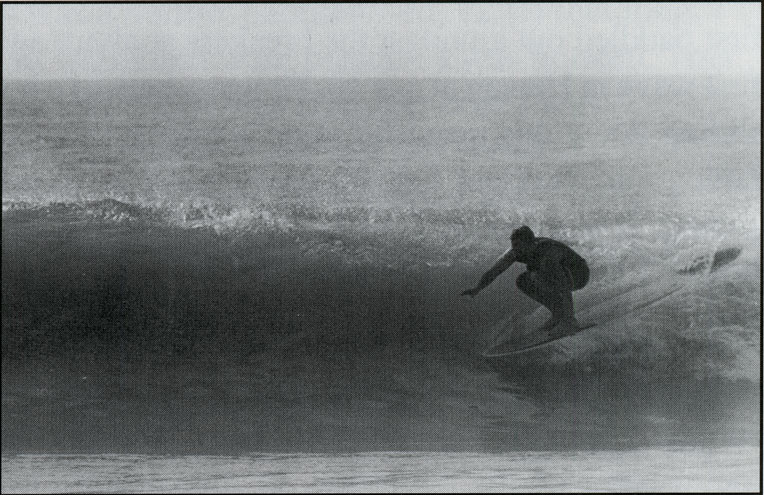
Bill Hubina was born in Bridgeport, Connecticut, and came to Reseda when he was seven years old. From Reseda he moved to Simi Valley. He graduated from Simi Valley High School in 1961. Hubina next attended Ventura College, where he started surfing during his junior year. According to Hubina, “I started in the business in ‘67, and sold [Ventura Surf Shop] to Stan [Fujii] in 1980, then Mark Ellison, who’s my partner, and I purchased the property, effective April 1, 2000.” Bill Hubina is now the managing partner of Ventura Surf Shop. He lives in Santa Barbara.
Can you describe the first time you went surfing, where this occurred, who was there at the time, and any feelings you have about that day?
I started during my junior year in high school [in 1960]. The first time I went surfing was at Malibu with a buddy of mine, Pat Delaney. Pat actually started surfing [first] and then he bought the [surfboard] kit, then there were a couple of other guys in the high school who surfed, so that’s how I started surfing. We were driving to Malibu, Zuma Beach and Ventura.
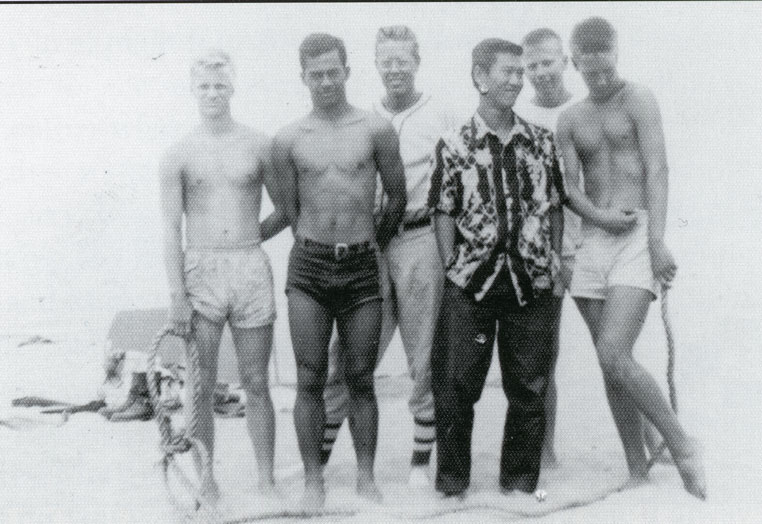
At the time you started surfing, can you recall who the “older guys” were at local surf spots? Do you recall any early female surfers?
In 1961, when I started surfing, the older guys that I knew and looked up to were Terry Jones, Bill Fury, Bill Westenbarger, who lived right out at the [Surfer’s] point—his whole family lived there. He was kind of the king of the point at the time I think. He was there … of course Tom Hale and Morey were in business at the time. That’s when I started to work, actually going to college and going to the Australian Surf Shop [where I] worked for Morey 1961-62. First as salesman, then making fins for Morey; anything Morey wanted me to do. There were other kids that I hung out with, Jim Redline, Mike Smith, Mike Arrambide, Tom McCawley. There was one gal, Jane, I don’t remember her last name, she was surfing, she had gone to college and was about seventeen at the time, she surfed at California Street, at C Street.
How (or from whom) did you acquire your first surfboard? Do you recall what you paid for this board? At that time what options were available to someone who wanted to acquire a surfboard, local or otherwise?
We [he and friend Pat Delaney] had ordered a surfboard kit from Surfer magazine; built a surfboard and tried it out at Malibu. Can’t remember what the make was, that was forty years ago. The whole thing cost about forty dollars.
From your time in the water, are there one or two memories that stand out from all others – people, waves, trips, equipment, etc.?
Pretty much my whole surfing life has been spectacular, there’s always a good day surfing. In 1969 I spent a month on the island Maui, I surfed Honaloa Bay, starting out at six feet all the way up to about 14-15 feet. That’s really thrilling to do for a month. That’s probably the highlight of my big wave surfing. I’ve had some great days at C Street; I’ve had waves where I virtually had to jump off of the Ventura Pier and paddle up to the Pipe [west of Surfer’s point] to get out, and surfed waves all the way from the Pipe to the Pier. That’s not uncommon. Mike Smith has done that, and some other guys … We didn’t have wetsuits at first in the early sixties at California Street—no one had wetsuits. Kids eventually started to come up with farmer johns and different suits from further south. Kids called them “southers” and we called them “rubber rats” cause they had rubber and we didn’t. We were just kind of envious. Since we didn’t have it, we made fun of them. We all wanted them, of course.
Have you had any experience with dolphins or sea lions? While surfing?
[I] see a lot dolphins out surfing actually. In the last few years I think we see more dolphins than we ever did. I’ve had dolphins share the same wave, or come up within four or five feet. In fact, it’s amazing, the sound they make when they come by, just their body through the water. Their sensations. They’re a big animal.When was the last time you went surfing? If you no longer surf, what reasons contributed to this decision?
I try to surf every day if the surf’s good. That’s why I’m back at the surf shop. I usually surf in the morning before work, and then after work, and on my days off I’ll go. That’s basically what I want to do every day is go surfing.
Do you have any feelings about surfers and/or surfing today?
I think there are more people getting into the sport every day. I think it is a growing sport. It’s a resurgence of surfing that I haven’t seen since the sixties. It’s interesting and it’s fun in this business because you’ll have a little kid come in, and the dad is with him, and the dad hasn’t surfed in twenty years, and within two or three weeks, the dad’s back again buying a wetsuit and he’s buying a surfboard, the dad’s back surfing again, and eventually mom’s surfing. So, you’re seeing a real family activity in surfing. And it’s healthy for you. There’s not a healthier sport you can get into … I think you’re seeing more families getting into surfing as a family activity, because it something that everybody in the family can go out and do, moms, dads, sisters, brothers, everyone.
Is there anything else you would like to add?
I could talk for days about surfing … I think the board has changed a lot. We’ve seen boards go from the long board to the short board and back to the long board, and now we have the long boards that are still long, but yet they’re maneuverable like the short boards. On the other hand, you have guys that are surfing the hybrid new long boards and guys that are surfing the classic old style long boards. You have people surfing different styles of surfboards, which is really a lot of fun to watch. Traditional old style surfers versus the new thrashing, go fast, do-everything-on-this-board tricks, spinners, upside down… and every day the younger kids are getting so good on these boards. The caliber of surfing that’s going on now, if people had seen this thirty years ago they wouldn’t have believed it.
Stan Fujii
Stan Fujii was born in 1952 in Torrance, California. In 1963 his family moved to Ventura where he attended Mound Elementary, Balboa and Cabrillo Junior High Schools. He graduated from Buena High School in 1970. He started surfing in 1964, when his friend Chris Buchanan took him to Marina Park Cove on a borrowed Ventura International Plastics surfboard, either a “Shark” or “Tiki” model. He describes his first experience as “typical … fell off the board a lot, drank some sea water, went home cold, but enjoyed myself.” Fujii became aware of “surf culture” about 1966 with classmates Greg “Poky” Smith and his brother, the Arrambides, Bob Carlson, Bob Gianelli, and two good friends: Coreen McCater and Pauline Murray; both women still get in the water and keep in touch. Fujii’s first surfboard purchase was “your typical used car story: went into Morey-Pope shop on Front Street and was sold a 9’10” board that was supposed to be 9’4” for $85—still can’t trust those used board salesmen.” Fujii later purchased this shop in March 1980. In 1995, he moved the business from 858 E. Front Street to its present location at 88 E. Thompson Blvd. In March 2000, he sold the Ventura Surf Shop to Bill “Blinky” Hubina and his partner, Mark Ellison.
Arthur C. Verge
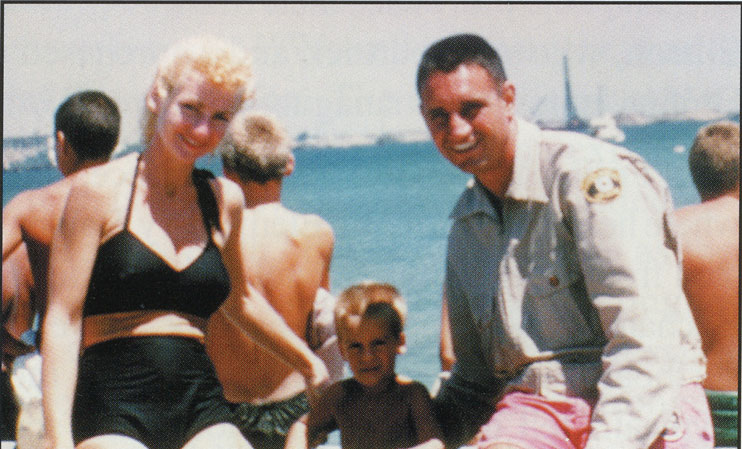
Arthur C. Verge was born in 1956 in Santa Monica, California. He attended “St. Monica’s High School,” Santa Monica College, and the University of California, Santa Barbara. He completed his graduate work at the University of Southern California in 1988. Because his father was a junior lifeguard instructor for the Santa Monica Lifeguard Service, Verge was first paddled out amongst the breakers at about age 4. He clearly remembers catching his first wave in Hawaii at age 10. “It was a tank of a board (a rental, of course), and I remember sliding down this beautiful slow-breaking wave and after, what was for me a long ride, falling into the clear bathtub warm water of paradise. Diamond Head stood in the background. It was unreal. Like Jack London, I was hooked.” His first board was a long board from ET Surfboards in Manhattan Beach; it cost $145.
Although, by his own account, Verge never developed into a “really good” surfer, he feels privileged, through his work in the lifeguard service, to have known two early legends of surfing: Pete Peterson and Tom Zahn. “They were always so kind to me. Both encouraged me to continue my education. In my capacity today as both historian and active ocean lifeguard, I feel honored to have been able to view their collections of photos and other memorabilia. What a great time it must have been when a group of more than four surfers off Malibu was considered crowded. When I became a lifeguard, Tom Zahn reminded me about the importance of surfing in making me ocean knowledgeable. He repeatedly said to never trust a lifeguard who doesn’t surf.’” Arthur Verge is presently working on a biography of pioneer surfer George Douglas Freeth.
The Future of Surfing: The View from Here
by Stan Fujii
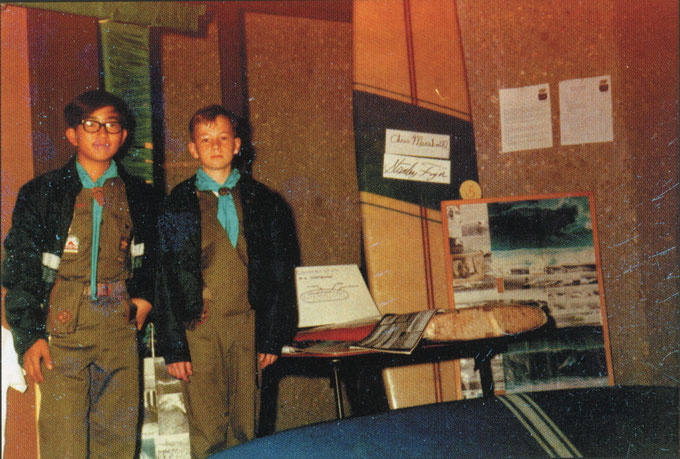
For me, surfing has always been about friendships. You go to the beach with friends. You buy your surfboards with your friends’ approval. You hang out with friends, and you share your best surfing experiences with your friends.
So starts a long line of friendships; in my case, from the marina “cove” with classmate Chris Buchanan on a borrowed Ventura International Plastics “Shark” or “Tiki” surfboard. Later, I was introduced to Wm. “Blinky” Rubina by team rider James Friend. The road has been filled with great names, always directed by friendships.
It is through many of those friendships that I now judge where we have come from and where I feel surfing is today. What was once counterculture has become mainstream, and yet the experience of surfing still holds a certain mystique that calls us to further consider the possibilities.
Surfing has continued to evolve, effected both by the ability level of the “core” surfers, as well as by changes in surfboard design. Lighter boards mean quicker reactions, which translates to tighter, more explosive maneuvers. This, in turn, would seem to demand more from a product, or product design—to meet the advanced ability of the surfer. The logical conclusion would be to use more and more advanced technology in equipment design and materials to further this progression, but the surfing community has not embraced this logic. Not because it hasn’t been offered; consider Hobie Alter’s sandwich-construction catamarans, Karl Pope’s hollow W.A.VE. surfboards, or Hoyle Schwitzer’s “Windsurfer.” These innovations have been rejected because of their monetary cost, as well as their social cost to the surfer who veers from what is acceptable, what is “cool.” Surfers, how many times have you asked for the “deal,” in a surf shop, then said to yourself, “I think I’ll try the other place in search of the ‘holy grail’.” Is the grail of surfboard design out there? I’m glad some of us still search for it. But what is it really? Have you defined it? Have you really thought of the aspects of the instrument that best translate your abilities to motion in the water? Can you describe it, or is it just luck that some of us happen to momentarily find it in a particular shape or material?
Most true experimentation is still deep underground, not because the manufacturers won’t produce it, but because they can’t sell it. Most surfers won’t spend the necessary time to develop something new—too much time, too much effort. They would have to rethink how they surf, and that means a lost day of surfing. Watch what comes out into the water on a “good day.”
So, what can we expect to see in the near future? Pretty much the same kinds of materials and design. Simon Anderson’s three-finned “thruster” hasn’t changed much in the last twenty years, and surfboard construction methods haven’t changed since the 1940s. We have not taken advantage of new advances in design and technology to change the product. Karl Pope’s hollow mold production process could have made the Campbell Brothers’ five-finned “Bonzer” much more technically advanced. Tom Morey still has not fully realized his design fantasies—his visions of what could be—through his boogie board and cardboard/silicon surfboards.
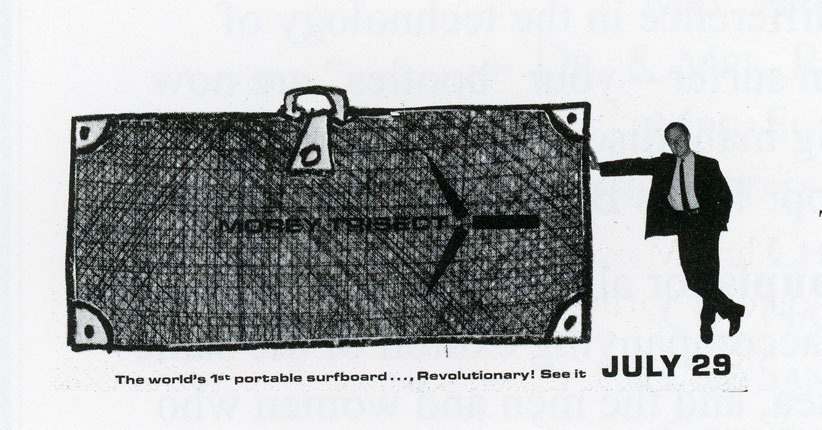
Can we see beyond our present situation? Will it be someone within the surfing industry who makes the real breakthrough, or will it be someone like Gen Kirila and his “VEC” computer-assisted molding process in Pittsburgh, who will pull us from the depths to see new possibilities?
Because we have a finite number of surf spots, we will also need to embrace change on another, larger scale, like Yvon Chouinard’s artificial reefs. The “Big Surfs” and “Wave Riders,” both kiddie rides, are the first step in the use of a technology that could be applied to open ocean park settings. This is not the time to be cheap with our support of innovation, because it is the thing that will allow us to advance our abilities and enjoy the possibilities.
Make History!
Support The Museum of Ventura County!
Membership
Join the Museum and you, your family, and guests will enjoy all the special benefits that make being a member of the Museum of Ventura County so worthwhile.
Support
Your donation will help support our online initiatives, keep exhibitions open and evolving, protect collections, and support education programs.


